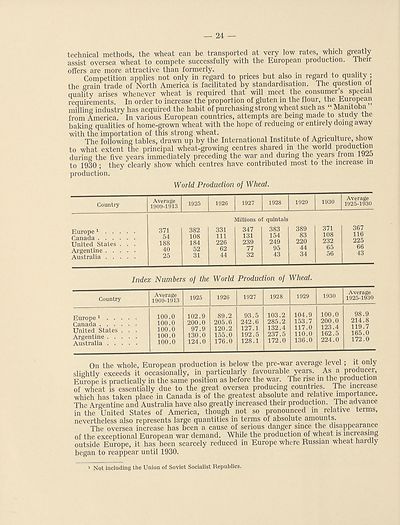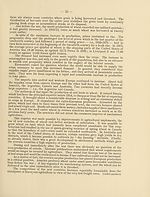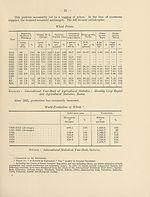Download files
Complete book:
Individual page:
Thumbnail gallery: Grid view | List view

— 24 —
technical methods, the wheat can be transported at very low rates which greatly
assist oversea wheat to compete successfully with the European production. 1 hen-
offers are more attractive than formerly.
Competition applies not only in regard to prices but also in regard to quality ;
the grain trade of North America is facilitated by standardisation. The question oi
quality arises whenever wheat is required that will meet the consumei s specia
requirements. In order to increase the proportion of gluten in the flour, the European
milling industry has acquired the habit of purchasing strong wheat such as Manitoba
from America. In various European countries, attempts are being made to study the
baking qualities of home-grown wheat with the hope of reducing or entirely doing away
with the importation of this strong wheat. „ t . 1JL .
The following tables, drawn up by the International Institute of Agriculture, show
to what extent the principal wheat-growing centres shared in the world production
during the five years immediately preceding the war and during the years from iy2b
to 1930 ; they clearly show which centres have contributed most to the increase m
production.
World Production of Wheat.
Country
Average
1909-1913
1925
1926
1927
1928
1929
1930
Average
1925-1930
Millions of quintals
Europe1 . .
Canada . . .
United States
Argentine . .
Australia . .
371
54
188
40
25
382
108
184
52
31
331
111
226
62
44
347
131
239
77
32
383
154
249
95
43
389
83
220
44
34
371
108
232
65
56
367
116
225
66
43
Index Numbers of the World Production of Wheat.
Country
Europe1 . .
Canada . . .
United States
Argentine . .
Australia . .
Average
1909-1913
100.0
100.0
100.0
100.0
100.0
1925
102.9
200.0
97.9
130.0
124.0
1926
89.2
205.6
120.2
155.0
176.0
1927
93.5
242.6
127.1
192.5
128.1
1928
103.2
285.2
132.4
237.5
172.0
1929
104.9
153.7
117.0
110.0
136.0
1930
100.0
200.0
123.4
162.5
224.0
Average
1925-1930
98.9
214.8
119.7
165.0
172.0
On the whole, European production is below the pre-war average level ; it only
slightly exceeds it occasionally, in particularly favourable years. As a producer,
Europe is practically in the same position as before the war. The rise in the production
of wheat is essentially due to the great oversea producing countries. The increase
which has taken place in Canada is of the greatest absolute and relative importance.
The Argentine and Australia have also greatly increased their production, the advance
in the United States of America, though not so pronounced in relative terms,
nevertheless also represents large quantities in terms of absolute amounts.
The oversea increase has been a cause of serious danger since the disappearance
of the exceptional European war demand. While the production of wheat is increasing
outside Europe, it has been scarcely reduced in Europe where Russian wheat hardly
began to reappear until 1930.
1 Not including the Union of Soviet Socialist Republics.
technical methods, the wheat can be transported at very low rates which greatly
assist oversea wheat to compete successfully with the European production. 1 hen-
offers are more attractive than formerly.
Competition applies not only in regard to prices but also in regard to quality ;
the grain trade of North America is facilitated by standardisation. The question oi
quality arises whenever wheat is required that will meet the consumei s specia
requirements. In order to increase the proportion of gluten in the flour, the European
milling industry has acquired the habit of purchasing strong wheat such as Manitoba
from America. In various European countries, attempts are being made to study the
baking qualities of home-grown wheat with the hope of reducing or entirely doing away
with the importation of this strong wheat. „ t . 1JL .
The following tables, drawn up by the International Institute of Agriculture, show
to what extent the principal wheat-growing centres shared in the world production
during the five years immediately preceding the war and during the years from iy2b
to 1930 ; they clearly show which centres have contributed most to the increase m
production.
World Production of Wheat.
Country
Average
1909-1913
1925
1926
1927
1928
1929
1930
Average
1925-1930
Millions of quintals
Europe1 . .
Canada . . .
United States
Argentine . .
Australia . .
371
54
188
40
25
382
108
184
52
31
331
111
226
62
44
347
131
239
77
32
383
154
249
95
43
389
83
220
44
34
371
108
232
65
56
367
116
225
66
43
Index Numbers of the World Production of Wheat.
Country
Europe1 . .
Canada . . .
United States
Argentine . .
Australia . .
Average
1909-1913
100.0
100.0
100.0
100.0
100.0
1925
102.9
200.0
97.9
130.0
124.0
1926
89.2
205.6
120.2
155.0
176.0
1927
93.5
242.6
127.1
192.5
128.1
1928
103.2
285.2
132.4
237.5
172.0
1929
104.9
153.7
117.0
110.0
136.0
1930
100.0
200.0
123.4
162.5
224.0
Average
1925-1930
98.9
214.8
119.7
165.0
172.0
On the whole, European production is below the pre-war average level ; it only
slightly exceeds it occasionally, in particularly favourable years. As a producer,
Europe is practically in the same position as before the war. The rise in the production
of wheat is essentially due to the great oversea producing countries. The increase
which has taken place in Canada is of the greatest absolute and relative importance.
The Argentine and Australia have also greatly increased their production, the advance
in the United States of America, though not so pronounced in relative terms,
nevertheless also represents large quantities in terms of absolute amounts.
The oversea increase has been a cause of serious danger since the disappearance
of the exceptional European war demand. While the production of wheat is increasing
outside Europe, it has been scarcely reduced in Europe where Russian wheat hardly
began to reappear until 1930.
1 Not including the Union of Soviet Socialist Republics.
Set display mode to:
![]() Universal Viewer |
Universal Viewer | ![]() Mirador |
Large image | Transcription
Mirador |
Large image | Transcription
Images and transcriptions on this page, including medium image downloads, may be used under the Creative Commons Attribution 4.0 International Licence unless otherwise stated. ![]()
| League of Nations > Economic and financial section > Agricultural crisis > Volume 1 > (26) |
|---|
| Permanent URL | https://digital.nls.uk/190902988 |
|---|
| Shelfmark | LN.II.2/2.(35) |
|---|---|
| Attribution and copyright: |
|
| Shelfmark | LN.II.2/2.(35-35) |
|---|---|
| Shelfmark | LN.II |
|---|
| Description | Over 1,200 documents from the non-political organs of the League of Nations that dealt with health, disarmament, economic and financial matters for the duration of the League (1919-1945). Also online are statistical bulletins, essential facts, and an overview of the League by the first Secretary General, Sir Eric Drummond. These items are part of the Official Publications collection at the National Library of Scotland. |
|---|---|
| Additional NLS resources: |
|

